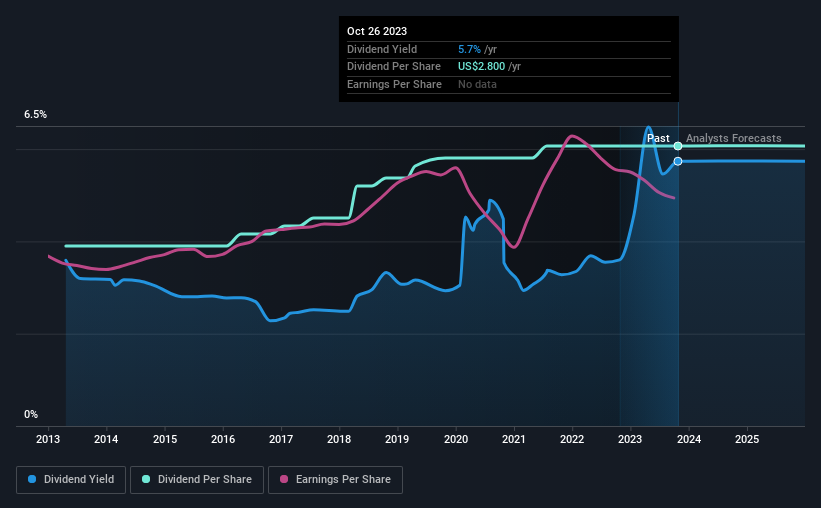
Bank of Hawaii Corporation (NYSE:BOH) has announced that it will pay a dividend of $0.70 per share on the 14th of December. This means the annual payment is 5.7% of the current stock price, which is above the average for the industry.
Check out our latest analysis for Bank of Hawaii
Bank of Hawaii's Earnings Will Easily Cover The Distributions
We like to see robust dividend yields, but that doesn't matter if the payment isn't sustainable.
Bank of Hawaii has established itself as a dividend paying company with over 10 years history of distributing earnings to shareholders. Based on Bank of Hawaii's last earnings report, the payout ratio is at a decent 57%, meaning that the company is able to pay out its dividend with a bit of room to spare.
Looking forward, earnings per share is forecast to fall by 29.8% over the next 3 years. Fortunately, analysts forecast the future payout ratio to be 73% over the same time horizon, which is in the range that makes us comfortable with the sustainability of the dividend.

Bank of Hawaii Has A Solid Track Record
The company has an extended history of paying stable dividends. Since 2013, the dividend has gone from $1.80 total annually to $2.80. This implies that the company grew its distributions at a yearly rate of about 4.5% over that duration. Although we can't deny that the dividend has been remarkably stable in the past, the growth has been pretty muted.
Bank of Hawaii May Find It Hard To Grow The Dividend
The company's investors will be pleased to have been receiving dividend income for some time. Let's not jump to conclusions as things might not be as good as they appear on the surface. Bank of Hawaii hasn't seen much change in its earnings per share over the last five years.
In Summary
In summary, while it's good to see that the dividend hasn't been cut, we are a bit cautious about Bank of Hawaii's payments, as there could be some issues with sustaining them into the future. The low payout ratio is a redeeming feature, but generally we are not too happy with the payments Bank of Hawaii has been making. We would probably look elsewhere for an income investment.
Market movements attest to how highly valued a consistent dividend policy is compared to one which is more unpredictable. Still, investors need to consider a host of other factors, apart from dividend payments, when analysing a company. As an example, we've identified 1 warning sign for Bank of Hawaii that you should be aware of before investing. Is Bank of Hawaii not quite the opportunity you were looking for? Why not check out our selection of top dividend stocks.
Valuation is complex, but we're here to simplify it.
Discover if Bank of Hawaii might be undervalued or overvalued with our detailed analysis, featuring fair value estimates, potential risks, dividends, insider trades, and its financial condition.
Access Free AnalysisHave feedback on this article? Concerned about the content? Get in touch with us directly. Alternatively, email editorial-team (at) simplywallst.com.
This article by Simply Wall St is general in nature. We provide commentary based on historical data and analyst forecasts only using an unbiased methodology and our articles are not intended to be financial advice. It does not constitute a recommendation to buy or sell any stock, and does not take account of your objectives, or your financial situation. We aim to bring you long-term focused analysis driven by fundamental data. Note that our analysis may not factor in the latest price-sensitive company announcements or qualitative material. Simply Wall St has no position in any stocks mentioned.
About NYSE:BOH
Bank of Hawaii
Operates as the bank holding company for Bank of Hawaii that provides various financial products and services in Hawaii, Guam, and other Pacific Islands.
Flawless balance sheet established dividend payer.


